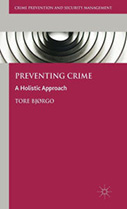PREVENTING CRIME: A HOLISTIC APPROACH

Author: Tore Bjørgo
Publisher: Basingstoke, Hampshire: Palgrave Macmillan, 2016. 322p.
Reviewer: Nick Tilley | January 2017
In the first chapter of Preventing Crime: A Holistic Approach, Tore Bjørgo outlines his overall approach. He goes on to exemplify it in the next five chapters. He concludes with some general comments on the application of a comprehensive preventive framework and on the evaluation of complex crime prevention initiatives.
Bjørgo adopts a holistic orientation to crime prevention, which is Nordic in inspiration. He proposes a comprehensive model for preventing crime, which turns on activating twelve preventive mechanisms. He presents these under three main headings: ‘building moral barriers’, ‘reducing recruitment’, ‘general deterrence’, ‘proactive incapacitation’, ‘disruption’ and ‘protecting vulnerable targets’ are placed under mechanisms intended to prevent a criminal act occurring. ‘Reactive incapacitation’ and ‘reducing harm’ are placed under mechanisms once a criminal act has occurred. ‘Specific deterrence’, ‘proactive incapacitation’, ‘reducing benefits’, and ‘rehabilitation’ and placed under mechanisms for preventing a criminal act occurring again. The twelve mechanisms are reduced to nine if specific and general deterrence, and if reactive and proactive incapacitation are combined.
Bjørgo recognizes that his classification of mechanisms is not the only one possible, but his schema does show how wide-ranging his conception of prevention is. He includes, for example, situational prevention, developmental prevention, criminal justice measures, restorative approaches, and concerns for reducing repeat offending and repeat victimization. He notes four main targets for preventive strategies: ‘whole population groups’ (often seen as primary prevention), ‘defined risk groups’ (often seen as secondary prevention), ‘problem groups’ (often seen as tertiary prevention) and ‘potential victims’ (not normally seen as a distinctive group but comprising those directly and indirectly harmed by crime).
The preventive mechanisms identified by Bjørgo can, he suggests, be activated in a variety of ways and involve actions by diverse agencies and organizations. He certainly recognizes a role for criminal justice organizations and in particular the police, but assigns responsibilities to many others also. Bjørgo’s chapters showing how his model works out in practice, focus on domestic burglary, violent youth crimes, organized crime originating from outlaw motorcycle clubs, driving under the influence, and terrorism. This is clearly not a comprehensive list of crime problems but illustrates a range of different types of crime problem. Bjørgo’s discussion of the prevention of each of these crime problems gives examples of what has been implemented to activate the range of mechanisms he lays out in his opening chapter.
Bjørgo draws on the best evidence he is able to find in relation to the preventive strategies he describes for the problems he considers, albeit that the evidence, as he acknowledges from time to time, is often not strong. Bjørgo is a professor of police science at the Norwegian Police University College and makes ample use of this as a source for much of the information he presents.
In discussing preventive measures, Bjørgo is assiduous in identifying the ‘prevention actors’ who need to be involved as well as the benefits and limitations of the measures described. He does not shrink from making judgments about what should be done. In that sense the book serves as a prescription for preventive efforts as well as an analytic account of preventive possibilities.
In his final chapter, Bjørgo comes out unsurprisingly in favor of comprehensive strategies using a complete ‘toolbox of prevention mechanisms’ for addressing complex crime problems. He argues for a broad evaluation approach that incorporates realist principles, which are attentive to how measures work in the contexts in which they are implemented.
This book deserves to be widely read by both researchers and practitioners, especially in Anglophone countries. It is refreshing in its emphasis on the importance of theory as well as evidence. The stimulus for the approach used, many of the examples of preventive work described, and much of the research that is drawn on, come from Scandinavian countries and from Norway in particular. There is much for the rest of the world to learn from their experience.
Nick Tilley, University College London


